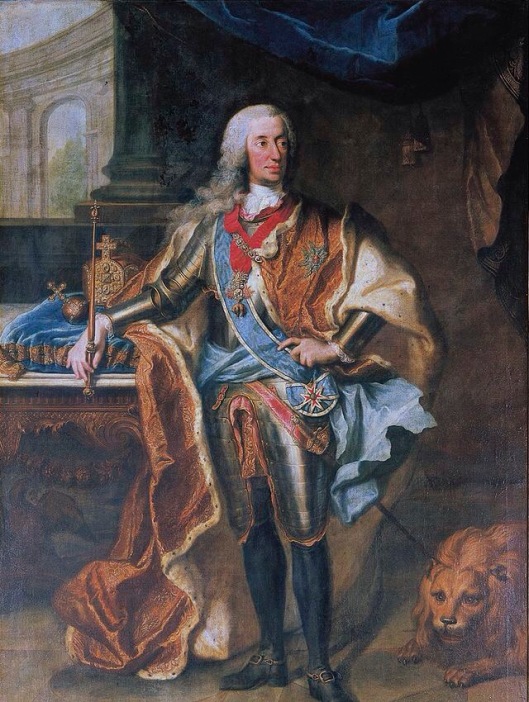Tags
Battle of Dettingen, Elector of Bavaria, Elector of Hanover, Frederick the Great, George II, Holy Roman Emperor, Holy Roman Emperor Charles VII, Holy Roman Empire, King Frederick II of Prussia, King George II of Great Britain, Pragmatic Sanction, War of the Austrian Succession
The War of the Austrian Succession (1740–1748) involved most of the powers of Europe over the issue of Archduchess Maria Theresa’s succession to the Habsburg Monarchy.
The immediate cause of the War of the Austrian Succession was the death of Holy Roman Emperor Carl VI (1685–1740) and the inheritance of the Habsburg Monarchy, often collectively referred to as ‘Austria’ (see Map).

Europe after the Treaty of Vienna (1738), Habsburg Monarchy in gold
Background
The 1703 Mutual Pact of Succession between Holy Roman Emperor Leopold I and his sons Archduke Joseph and Archduke Carl agreed that if the Habsburgs became extinct in the male line, their possessions would go first to female heirs of Joseph, then those of Carl. Since Salic law excluded women from the inheritance, this required approval by the various Habsburg territories and the Imperial Diet.
Holy Roman Emperor Joseph I died in 1711, leaving two daughters, Maria Josepha and Maria Amalia and his brother Carl succeeded his elder brother as Holy Roman Emperor Emperor Carl VI, King of Bohemia (as Carl II), King of Hungary and Croatia, Serbia and Archduke of Austria (as Carl III).

Holy Roman Emperor Carl VI
Carl VI became the last male Habsburg in the direct line. In April 1713, he issued the Pragmatic Sanction, permitting female inheritance but then placing his own hypothetical daughters ahead of Joseph I’s. It’s interesting to note that at this juncture Carl suspected he wouldn’t have any male heirs.
On August 1, 1708, the future Holy Roman Emperor Carl VI married Elisabeth Christine of Brunswick-Wolfenbüttel, the eldest daughter of Ludwig-Rudolph, Duke of Brunswick-Wolfenbüttel and his wife Princess Christine Louise of Oettingen-Oettingen.
When Carl’s daughter Maria Theresa was born in 1717, ensuring her succession dominated the rest of his reign. In 1719 Carl VI required his nieces Maria Joseph and Maria Amalia to renounce their rights in Maria Theresa’s favour in order to marry Friedrich-August of Saxony and Carl-Albert of Bavaria respectively. Carl VI hoped these marriages would secure his daughter’s position since neither Saxony or Bavaria could tolerate the other gaining control of the Habsburg inheritance but his actions undermined the logic of the settlement.
A family issue became a European one due to tensions within the Holy Roman Empire, caused by dramatic increases in the size and power of Bavaria, Prussia and Saxony, mirrored by the post 1683 expansion of Habsburg power into lands previously held by the Ottoman Empire. Further complexity then arose from the fact that the theoretically elected position of Holy Roman Emperor, which had been held by the Habsburgs since 1437, would be lost by the Habsburgs after the death of Emperor Carl VI.
Bavaria and Saxony refused to be bound by the decision of the Imperial Diet, while in 1738 France agreed to back the ‘just claims’ of Carl-Albert of Bavaria, despite previously accepting the Pragmatic Sanction in 1735. Attempts to offset this involved Austria in the 1734-1735 War of the Polish Succession and the Russo-Turkish War of 1735–1739, and it was weakened by the losses incurred. Compounded by the failure to prepare Maria Theresa for her new role, many European statesmen were sceptical that the Austrian lands could survive the contest that would follow Carl VI death, which finally occurred on October 20, 1740.

Maria Theresa, Queen of Hungry and Bohemia, Archduchess of Austria
Immediately after her accession, a number of European sovereigns who had recognised Maria Theresa as heir broke their promises. Elector Carl-Albert of Bavaria, married to Maria Theresa’s deprived cousin Archduchess Maria Amalia of Austria, coveted portions of her inheritance. Maria Theresa did secure recognition from King Carlo-Emmanuel III of Sardinia, who had not accepted the Pragmatic Sanction during her father’s lifetime, in November 1740.
In December the War of the Austrian Succession began when King Friedrich II of Prussia invaded the Duchy of Silesia and requested that Maria Theresa cede it, threatening to join her enemies if she refused. Maria Theresa decided to fight for the mineral Rich province.
Elector Carl-Albert of Bavaria invaded Upper Austria in 1741 and planned to conquer Vienna, but his allied French troops under the Duc de Belle-Isle were redirected to Bohemia instead and Prague was conquered in November 1741. So Carl-Albert was crowned King of Bohemia in Prague (December 19, 1741) when the Habsburgs were not yet defeated. He was unanimously elected “King of the Romans” on January 24, 1742, also with the vote of King George II of Great Britain (in his capacity as the Imperial Elector of Hanover) and became Holy Roman Emperor Carl VII upon his coronation on February 17, 1742.

Holy Roman Emperor Carl VII, Elector of Bavaria
One important battle of the War of the Austrian Succession was the Battle of Dettingen which took place on June 27, 1743 at Dettingen on the River Main, Holy Roman Empire. The British forces, in alliance with those of Hanover and Hesse, defeated a French army under the duc de Noailles. King George II of Great Britain, Imperial Elector of Hanover, commanded his troops in the battle, and this marked the last time a British monarch personally led his troops on the field. The battle straddled the river about 18 miles east of Frankfurt, with guns on the Hessian bank but most of the combat on the flat Bavarian bank. The village of Dettingen is today the town of Karlstein am Main, in the extreme northwest of Bavaria.

King George II of Great Britain at the Battle of Dettingen.

George II, King of Great Britain and Ireland and Imperial Elector of Hanover.
